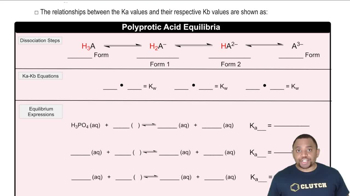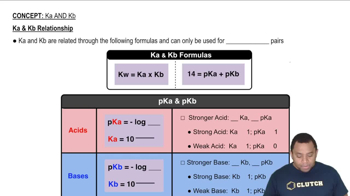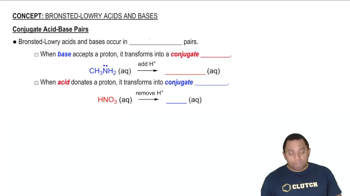Here are the essential concepts you must grasp in order to answer the question correctly.
Acid-Base Equilibrium
Acid-base equilibrium refers to the balance between acids and bases in a solution, characterized by the dissociation of acids into protons (H+) and their conjugate bases. The strength of an acid is quantified by its acid dissociation constant (Ka), while the strength of a base is represented by its base dissociation constant (Kb). Understanding this equilibrium is crucial for calculating the Ka values from given Kb values.
Recommended video:
Triprotic Acid Equilibrium
Relationship Between Ka and Kb
The relationship between the acid dissociation constant (Ka) and the base dissociation constant (Kb) is given by the equation Ka × Kb = Kw, where Kw is the ion product of water (1.0 × 10^-14 at 25°C). This relationship allows for the conversion of Kb values of basic ions into their corresponding Ka values, facilitating the analysis of their acidic properties.
Recommended video:
Conjugate Acid-Base Pairs
Conjugate acid-base pairs consist of an acid and its corresponding base that differ by a single proton. For example, when a base accepts a proton, it forms its conjugate acid. Recognizing these pairs is essential for understanding the behavior of ions in solution, as it helps in determining the strength of acids and bases and their respective dissociation constants.
Recommended video:
Conjugate Acid-Base Pairs
 Verified step by step guidance
Verified step by step guidance

